6.4. Working with Problem Components¶
This section covers the basics of problem components: what they look like to you and your learners, and the options that every problem component has.
For more information about individual problem types, see Creating Exercises and Tools.
6.4.1. Overview¶
The problem component allows you to add interactive, automatically graded exercises to your course content. You can create many different types of problems in Studio.
6.4.2. Graded Problems¶
All problems receive a point score, but, by default, problems do not count toward a learner’s grade.
To have problems to count toward the grade, change the assignment type of the subsection that contains the problems. For more information, see Set the Assignment Type and Due Date for a Subsection.
6.4.3. The Learner View of a Problem¶
All problems on the edX platform have several component parts.
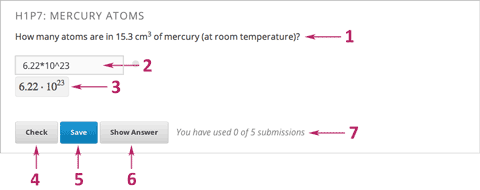
Problem text. The problem text can contain any standard HTML formatting.
Response field with the learner’s answer. Learners enter answers in response fields. The appearance of the response field depends on the type of the problem.
Rendered answer. For some problem types, Studio uses MathJax to render plain text as “beautiful math”.
Check button. The learner selects Check to submit a response or find out if his answer is correct. If the answer is correct, a green check mark appears. If it is incorrect, a red X appears. When the learner selects the Check button, the Learning Management System saves the grade and current state of the problem.
Save button. The learner can select Save to save her current response without submitting it for a grade. This allows the learner to stop working on a problem and come back to it later.
Show Answer button. This button is optional. When the learner selects Show Answer, she sees both the correct answer (see 2 above) and the explanation (see 10 below). You define whether the Show Answer button is visible.
Attempts. You can set a specific number of attempts, or allow unlimited attempts for a problem. By default, the course-wide Maximum Attempts advanced setting is null, meaning that the maximum number of attempts for problems is unlimited. If the course-wide Maximum Attempts setting is changed to a specific number, the Maximum Attempts setting for individual problems defaults to that number, and cannot be set to unlimited.
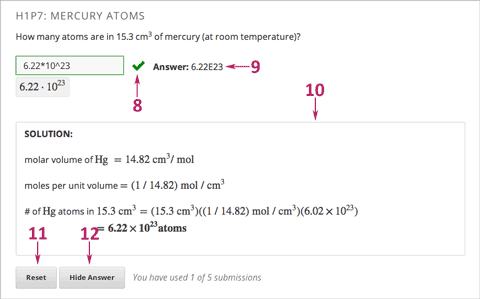
Feedback. After a learner selects Check, all problems return a green check mark or a red X.

Correct answer. Most problems require that you specify a single correct answer.
Explanation. You can include an explanation that appears when a learner selects Show Answer.
Reset button. Learners can select Reset to clear any input that has not yet been submitted, and try again to answer the question.
- If the learner has already submitted an answer, selecting Reset clears the submission and, if the problem includes a Python script to randomize variables and the randomization setting is On Reset, changes the values the learner sees in the problem.
- If the number of Maximum Attempts that was set for this problem has been reached, the Reset button is not visible.
Hide Answer button.

Grading. You can specify whether a group of problems is graded. If a group of problems is graded, a clock icon appears for that assignment in the left pane.

Due date. The date that the problem is due. A problem that is past due does not have a Check button. It also does not accept answers or provide feedback.
Note
Problems can be open or closed. Closed problems do not have a Check button. Learners can still see questions, solutions, and revealed explanations, but they cannot check their work, submit responses, or change an earlier score.
There are also some attributes of problems that are not immediately visible. You can set these attributes in Studio.
Randomization. In certain types of problems, you can include a Python script to randomize the values that are presented to learners. You use this setting to define when values are randomized.
- Weight. Different problems in a particular problem set can be
given different weights.
Label. To improve accessibility for learners who have disabilities, each problem needs a descriptive label. The label typically contains part or all of the text of the question in the problem. Most templates include a space for a label. You can find example labels in the documentation for each problem or tool type.
6.4.4. The Studio View of a Problem¶
All problems are written in XML. However, Studio offers two interfaces for editing problem components: the Simple Editor and the Advanced Editor.
- The Simple Editor allows you to edit problems visually, without having to work with XML.
- The Advanced Editor converts the problem to edX’s XML standard and allows you to edit that XML directly.
You can switch at any time from the Simple Editor to the Advanced Editor by selecting Advanced Editor in the top right corner of the Simple Editor interface. However, after you save a problem in the Advanced Editor, you cannot open it again in the Simple Editor.
6.4.4.1. The Simple Editor¶
When you select the following problem types, the Simple Editor opens with a preformatted example problem.
- Checkbox Problem: In checkbox problems, learners select one or more options from a list of possible answers.
- Dropdown Problem: In dropdown problems, learners select one answer from a dropdown list.
- Multiple Choice Problem: Multiple choice problems require learners to select one answer from a list of choices that appear directly below the question.
- Numerical Input Problem: Numerical input problems require answers that include only integers, fractions, and a few common constants and operators.
- Text Input Problem: In text input problems, learners enter a short text answer to a question.
The following image shows an example multiple choice problem in the Simple Editor.
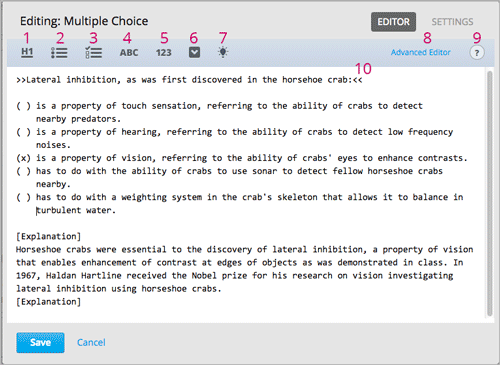
The Simple Editor includes a toolbar with options that provide the required formatting for different types of problems. When you select an option from the toolbar, formatted sample text appears in the Simple Editor. Alternatively, you can apply formatting to your own text by selecting the text and then one of the toolbar options.
Descriptions of the toolbar options follow.
- Heading 1: Format text as a first level heading.
- Multiple Choice: Identify the text on each selected line as an answer option for a multiple choice problem.
- Checkboxes: Identify the text on each selected line as an answer option for a checkboxes problem.
- Text Input: Identify the correct answer for a text input problem.
- Numerical Input: Identify the correct answer, with an optional tolerance, for a numerical input problem.
- Dropdown: Identify a comma-separated list as the answer options for a dropdown problem.
- Explanation: Format text as an explanation that appears when learners select Show Answer.
- Open the problem in the Advanced Editor.
- Open a list of formatting hints.
- Accessible Label: Identify the question as the problem’s accessible label. No toolbar option is available, but when you surround text with two pairs of angle brackets pointing inward (
>>question<<), screen readers use that text as the accessible label for the problem. In addition, edX Insights uses the accessible label to identify the question in each problem. For more information, see Using edX Insights.
6.4.4.2. The Advanced Editor¶
The Advanced Editor opens a problem in XML. Templates for problems such as such as drag and drop and math expression input open directly in the Advanced Editor.
The following image shows the multiple choice problem above in the Advanced Editor instead of the Simple Editor.

The following problem templates open in the Advanced Editor.
- Circuit Schematic Builder Problem In circuit schematic problems, learners create and modify circuits on an interactive grid and submit computer- generated analyses of the circuits for grading.
- Custom JavaScript Problem With custom JavaScript problems, you can create a custom problem or tool that uses JavaScript and add it directly into Studio.
- Drag and Drop Problem Drag and drop problems require learners to drag text or objects to a specific location on an image.
- Image Mapped Input Problem Image mapped input problems require learners to select a specific location on an image.
- Math Expression Input Problems Math expression input problems require learners to enter a mathematical expression as text, such as e=m*c^2.
- Problem with Adaptive Hint These problems can give learners feedback or hints based on their responses. Problems with adaptive hints can be text input or multiple choice problems.
- Problem Written in LaTeX This problem type allows you to convert problems that you previously wrote in LaTeX into the edX format. Note that this problem type is a prototype, and is not supported.
- Write-Your-Own-Grader Problem Custom Python-evaluated input (also called “write-your-own-grader” problems evaluate learners’ responses using an embedded Python script that you create. These problems can be of any type.
6.4.5. Problem Settings¶
In addition to the text of the problem, problems that you create using a problem component have the following settings. To access these settings you select Settings in the component editor.
6.4.5.1. Display Name¶
This setting indicates the name of your problem. This name appears for learners as a heading above the problem and as a tooltip in the learning sequence at the top of the Courseware page.

In addition, edX Insights uses the display name to identify each problem. Unique, descriptive display names help you identify problems quickly and accurately for analysis. For more information, see Using edX Insights.
6.4.5.2. Maximum Attempts¶
This setting specifies the number of times that a learner is allowed to attempt answering a problem. By default, the course-wide Maximum Attempts advanced setting is null, meaning that the maximum number of attempts for problems is unlimited. If the course-wide Maximum Attempts setting is changed to a specific number, the Maximum Attempts setting for individual problems defaults to that number, and cannot be set to unlimited.
Note
edX recommends setting Maximum Attempts to either unlimited or a very large number. Unlimited attempts allow for mastery learning and encourages risk taking and experimentation, both of which lead to improved learning outcomes. Allowing for unlimited attempts might be impossible in some courses, such as those where grading is primarily based on multiple choice questions.
Note
Only questions that have a Maximum Attempts setting of 1 or higher are included in the answer distribution computations used in edX Insights and the Student Answer Distribution report.
6.4.5.3. Problem Weight¶
Note
The Learning Management System stores scores for all problems, but scores only count toward a learner’s final grade if they are in a subsection that is graded.
This setting specifies the total number of points possible for the problem. The problem weight appears next to the problem’s display name.
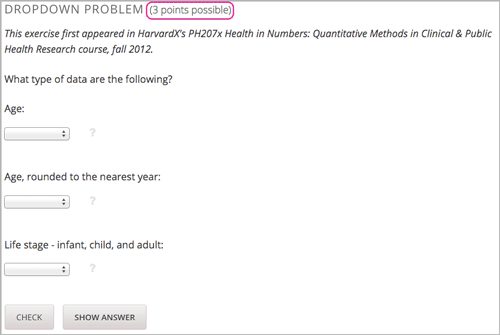
By default, each response field, or “answer space”, in a problem component is worth one point. Any problem component can have multiple response fields. For example, the problem component above contains one dropdown problem that has three separate questions, and also has three response fields.
You can increase or decrease the weight for a problem component by entering a Problem Weight.
6.4.5.3.1. Computing Scores¶
The score that a learner earns for a problem is the result of the following formula.
Score = Weight × (Correct answers / Response fields)
- Score is the point score that the learner receives.
- Weight is the problem’s maximum possible point score.
- Correct answers is the number of response fields that contain correct answers.
- Response fields is the total number of response fields in the problem.
Examples
The following are some examples of computing scores.
Example 1
A problem’s Weight setting is left blank. The problem has two response fields. Because the problem has two response fields, the maximum score is 2.0 points.
If one response field contains a correct answer and the other response field contains an incorrect answer, the learner’s score is 1.0 out of 2 points.
Example 2
A problem’s weight is set to 12. The problem has three response fields.
If a learner’s response includes two correct answers and one incorrect answer, the learner’s score is 8.0 out of 12 points.
Example 3
A problem’s weight is set to 2. The problem has four response fields.
If a learner’s response contains one correct answer and three incorrect answers, the learner’s score is 0.5 out of 2 points.
6.4.5.4. Randomization¶
For problems that include a Python script to generate numbers randomly, this setting specifies how frequently the values in the problem change: each time a different learner accesses the problem, each time a single learner tries to answer the problem, both, or never.
Note
This setting should only be set to an option other than Never for problems that are configured to do random number generation.
For example, in this problem, the highlighted values change each time a learner submits an answer to the problem.
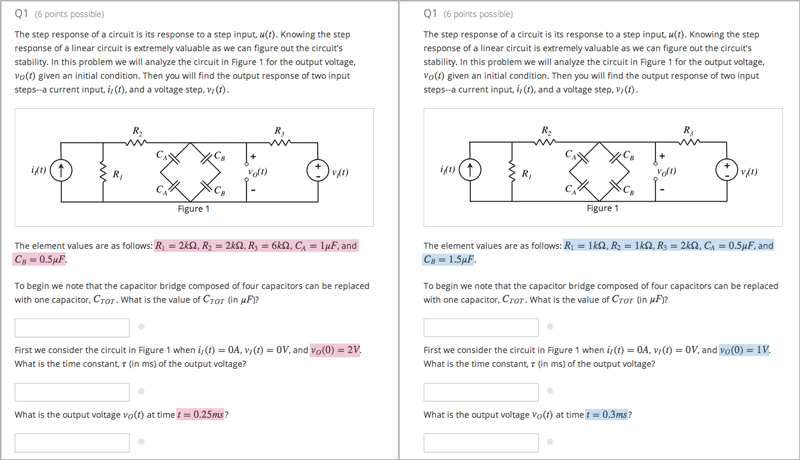
If you want to randomize numeric values in a problem, you complete both of these steps.
- Make sure that you edit your problem to include a Python script that randomly generates numbers.
- Select an option other than Never for the Randomization setting.
Note
The Randomization setting serves a different purpose from “problem randomization”. The Randomization setting affects how numeric values are randomized within a single problem and requires the inclusion of a Python script. Problem randomization offers different problems or problem versions to different learners. For more information, see Problem Randomization.
The edX Platform has a 20-seed maximum for randomization. This means that learners see up to 20 different problem variants for every problem that has Randomization set to an option other than Never. It also means that every answer for the 20 different variants is reported by the Answer Distribution report and edX Insights. Limiting the number of variants to a maximum of 20 allows for better analysis of learner submissions by allowing you to detect common incorrect answers and usage patterns for such answers.
For more information, see Student Answer Distribution in this guide, or Review Answers to Graded Problems or Review Answers to Ungraded Problems in Using edX Insights.
Important
Whenever you choose an option other than Never for a problem, the computations for the Answer Distribution report and edX Insights include up to 20 variants for the problem, even if the problem was not actually configured to include randomly generated values. This can make data collected for problems that cannot include randomly generated values, (including, but not limited to, all multiple choice, checkboxes, dropdown, and text input problems), extremely difficult to interpret.
You can choose the following options for the Randomization setting.
| Option | Description |
|---|---|
| Always | Learners see a different version of the problem each time they select Check. |
| On Reset | Learners see a different version of the problem each time they select Reset. |
| Never | All learners see the same version of the problem. For most courses, this option is supplied by default. Select this option for every problem in your course that does not include a Python script to generate random numbers. |
| Per Student | Individual learners see the same version of the problem each time they look at it, but that version is different from the version that other learners see. |
6.4.5.5. Show Answer¶
This setting defines when learners are shown the answers to a problem and has the following options
| Always | Always show the answer when the learner selects the Show Answer button. |
| Answered | Show the answer after the learner tries to answer the problem. If the question can be, and is, reset, the answer is not shown until the learner tries the problem again. (When a learner answers a question, the question is considered to be both attempted and answered. When the question is reset, the question is still attempted, but not yet answered.) |
| Attempted | Show the answer after the learner tries to answer the problem. If the question can be, and is, reset, the answer continues to show. (When a learner answers a question, the question is considered to be both attempted and answered. When the question is reset, the question is still attempted, but not yet answered.) |
| Closed | Show the answer after the learner has used up all his attempts to answer the problem or the due date has passed. |
| Finished | Show the answer after the learner has answered the problem correctly, the learner has no attempts left, or the problem due date has passed. |
| Correct or Past Due | Show the answer after the learner has answered the problem correctly or the problem due date has passed. |
| Past Due | Show the answer after the due date for the problem has passed. |
| Past Due | Never show the answer. In this case, a Show Answer button does not appear next to the problem in Studio or in the LMS. |
6.4.5.6. Show Reset Button¶
This setting defines whether a Reset button is visible on the problem.
Learners can select Reset to clear any input that has not yet been submitted, and try again to answer the problem.
If the learner has already submitted an answer, selecting Reset clears the submission and, if the problem contains randomized variables and randomization is set to On Reset, changes the values in the problem.
If the number of Maximum Attempts that was set for this problem has been reached, the Reset button is not visible.
This problem-level setting overrides the course-level Show Reset Button for Problems setting.
6.4.5.7. Timer Between Attempts¶
This setting specifies the number of seconds that a learner must wait between submissions for a problem that allows multiple attempts. If the value is 0, the learner can attempt the problem again immediately after an incorrect attempt.
Adding required wait time between attempts can help to prevent learners from simply guessing when multiple attempts are allowed.
If a learner attempts a problem again before the required time has elapsed, she sees a message below the problem indicating the remaining wait time. The format of the message is, “You must wait at least {n} seconds between submissions. {n} seconds remaining.”
6.4.6. Modifying a Released Problem¶
Warning
Be careful when you modify problems after they have been released. Changes that you make to published problems can affect the learner experience in the course and analysis of course data.
After a learner submits a response to a problem, the edX Learning Management System (LMS) stores that response, the score that the learner received, and the maximum score for the problem. For problems with a Maximum Attempts setting greater than 1, the LMS updates these values each time the learner submits a new response to a problem. However, if you change a problem or its attributes, existing learner information for that problem is not automatically updated.
For example, you release a problem and specify that its answer is 3. After some learner have submitted responses, you notice that the answer should be 2 instead of 3. When you update the problem with the correct answer, the LMS does not update scores for learners who originally answered 2 for the problem and received the wrong score.
For another example, you change the number of response fields to three. Learners who submitted answers before the change have a score of 0, 1, or 2 out of 2.0 for that problem. Learners who submitted answers after the change have scores of 0, 1, 2, or 3 out of 3.0 for the same problem.
If you change the weight setting for the problem in Studio, however, existing scores update when the learner’s Progress page is refreshed. In a live section, learners will see the effect of these changes.
6.4.6.1. Workarounds¶
If you have to modify a released problem in a way that affects grading, you have two options to ensure that every learner has the opportunity to submit a new response and be regraded. Note that both options require you to ask your learners to go back and resubmit answers to a problem.
- In the problem component that you changed, increase the number of attempts for the problem, then ask all your learners to redo the problem.
- Delete the entire problem component in Studio and create a new Problem component with the content and settings that you want, then ask all your learners to complete the new problem. (If the revisions you must make are minor, duplicate the problem component before you delete it and revise the copy.)
For information about how to review and adjust learner grades in the LMS, see Student Grades and Grading.
6.4.7. Multiple Problems in One Component¶
You might want to create a problem that has more than one response type. For example, you might want to create a numerical input problem and then include a multiple choice question about that numerical input problem. Or, you might want a learner to be able to check the answers to many problems at one time. To do this, you can include multiple problems inside a single problem component. The problems can be different types.
Note
You cannot use a Custom JavaScript Problem in a component that contains more than one problem. Each custom JavaScript problem must be in its own component.
To create multiple problems in one component, create a new Blank Advanced problem component, and then add the XML for each problem in the component editor. You only need to include the XML for the problem and its answers. You do not have to include the code for other elements, such as the Check button.
Elements such as the Check, Show Answer, and Reset buttons, as well as the settings that you select for the problem component, apply to all of the problems in that component. Thus, if you set the maximum number of attempts to 3, the learner has three attempts to answer the entire set of problems in the component as a whole rather than three attempts to answer each problem individually. If a learner selects Check, the LMS scores all of the problems in the component at once. If a learner selects Show Answer, the answers for all the problems in the component appear.
6.4.8. Adding Feedback and Hints to a Problem¶
You can add feedback, hints, or both to the following problem types.
- Checkbox Problem
- Dropdown Problem
- Multiple Choice Problem
- Numerical Input Problem
- Text Input Problem
By using hints and feedback, you can provide learners with guidance and help as they work on problems.
6.4.8.1. Feedback in Response to Attempted Answers¶
You can add feedback that is displayed to learners when they submit an answer.
For example, the following multiple choice problem provides feedback in response to the selected option when the learner selects Check. In this case, feedback is given for an incorrect answer.
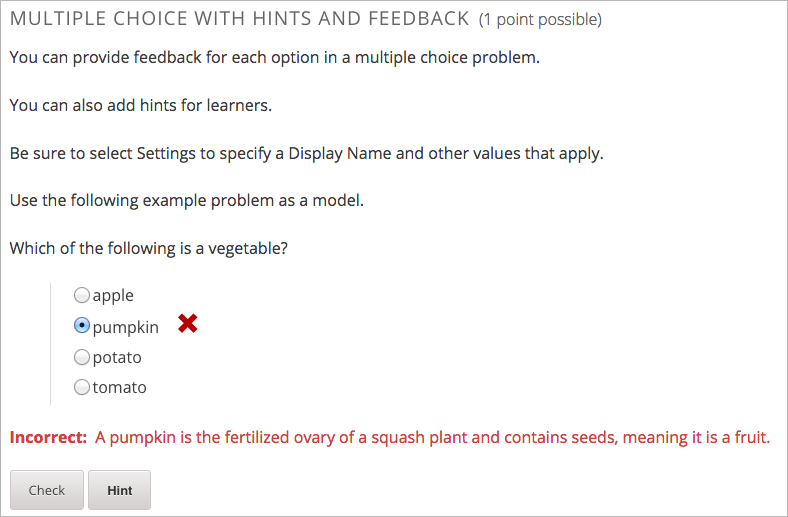
6.4.8.2. Best Practices for Providing Feedback¶
The immediacy of the feedback available to learners is a key advantage of online instruction and difficult to do in a traditional classroom environment.
You can target feedback for common incorrect answers to the misconceptions that are common for the level of the learner (for example, elementary, middle, high school, college).
In addition, you can create feedback that provides some guidance to the learner about how to arrive at the correct answer. This is especially important in text input and numeric input problems, because without such guidance, learners might not be able to proceed.
You should also include feedback for the correct answer to reinforce why the answer is correct. Especially in questions where learners are able to guess, such as multiple choice and dropdown problems, the feedback should provide a reason why the selection is correct.
6.4.8.3. General Hints to a Problem¶
You can add one or more hints that are displayed to learners. When you add hints, the Hint button is automatically displayed to learners. Learners can access the hints by selecting Hint beneath the problem. A learner can view multiple hints by selecting Hint multiple times.
For example, in the following multiple choice problem, the learner selects Hint before attempting the answer.

The hint indicates that it is the first of two hints. The learner selects Hint a second time.
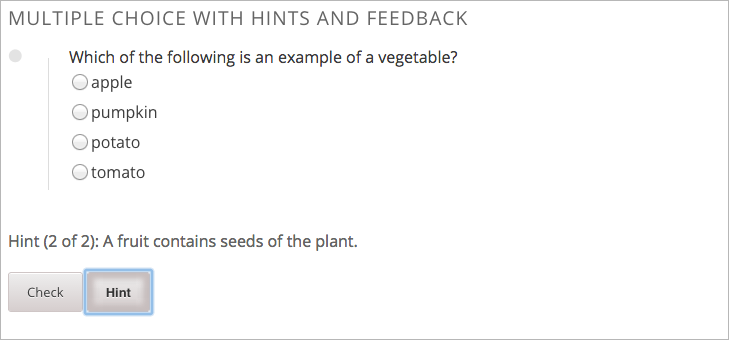
6.4.8.4. Best Practices for Providing Hints¶
To ensure that your hints can assist learners with varying backgrounds and levels of understanding, you should provide multiple hints with different levels of detail.
For example, the first hint can orient the learner to the problem and help those struggling to better understand what is being asked.
The second hint can then take the learner further towards the answer.
In problems that are not graded, the third and final hint can explain the solution for learners who are still confused.
6.4.8.5. Create Problems with Feedback and Hints¶
You create problems with feedback and hints in Studio. Templates with feedback and hints configured are available to make creating your own problems easier.
While editing a unit, in the Add New Component panel, select Problem. In the list that opens, select the Common Problem Types tab. Templates for problems with feedback and hints are listed.
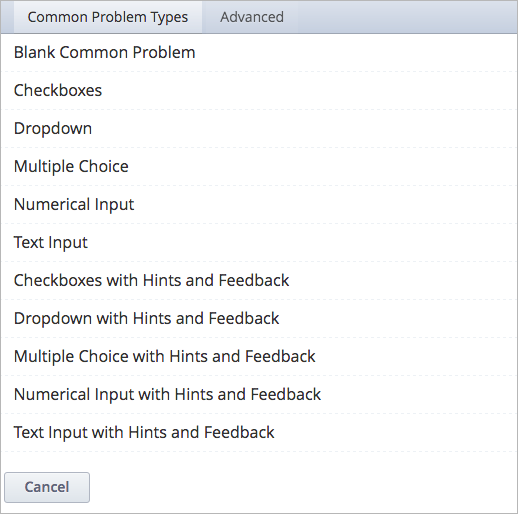
Add the problem type you need to the unit, then edit the component. The exact syntax you use to configure hints and feedback depends on the problem type. See the topic for the problem type for more information.
6.4.9. Problem Randomization¶
You might want to present different learners with different problems, or different versions of the same problem. To do this, you create a problem component for each problem or version in Studio, and then edit your course outside of Studio, in OLX, to randomize the problem that learners see.
Note that problem randomization is different from the Randomization setting in Studio. The Randomization setting controls when a Python script within a single problem randomizes variables. Problem randomization offers different problems or problem versions to different learners.
Note
Creating problems with versions that can be randomized requires you to export your course, edit some of your course’s XML files in a text editor, and then re-import your course. We recommend that you create a backup copy of your course before you do this. We also recommend that you only edit your course files in the text editor if you are very familiar with editing XML.
6.4.9.1. Terminology¶
Sections, subsections, units, and components have different names in the Course Outline view and in the list of files that you’ll see after you export your course and open the .xml files for editing. The following table lists the names of these elements in the Course Outline view and in a list of files.
| Course Outline View | File List |
| Section | Chapter |
| Subsection | Sequential |
| Unit | Vertical |
| Component | Discussion, HTML, problem, or video |
For example, when you want to find a specific section in your course, look in the Chapter directory when you open the list of files that your course contains. To find a unit, look in the Vertical directory.
6.4.9.2. Create Randomized Problems¶
In the unit where you want to create a randomized problem, create a separate problem component for each version or problem that you want to randomize. For example, if you want to offer four versions or problems, create four separate problem components. Make a note of the 32-digit unit ID that appears in the Unit Identifier field under Unit Location.
Export your course. For more information, see Exporting and Importing a Course. Save and extract the .tar.gz file that contains your course in a memorable location so that you can find it easily.
In the list of directories and files, open the Vertical directory.
Note
If your unit is not published, open the Drafts directory, and then open the Vertical directory in the Drafts folder.
In the Vertical folder, locate the .xml file that has the same name as the unit ID that you noted in step 1, and then open the file in a text editor such as Sublime. For example, if the unit ID is
e461de7fe2b84ebeabe1a97683360d31, open thee461de7fe2b84ebeabe1a97683360d31.xmlfile.The file contains a list of all the components in the unit, together with the URL names of the components. For example, the following file contains four problem components.
<vertical display_name="Test Unit"> <problem url_name="d9d0ceb3ffc74eacb29501183e26ad6e"/> <problem url_name="ea66d875f4bf4a9898d8e6d2cc9f3d6f"/> <problem url_name="2616cd6324704f85bc315ec46521485d"/> <problem url_name="88987707294d4ff0ba3b86921438d0c0"/> </vertical>
Add
<randomize> </randomize>tags around the components for the problems that you want to randomize.<vertical display_name="Test Unit"> <randomize> <problem url_name="d9d0ceb3ffc74eacb29501183e26ad6e"/> <problem url_name="ea66d875f4bf4a9898d8e6d2cc9f3d6f"/> <problem url_name="2616cd6324704f85bc315ec46521485d"/> <problem url_name="88987707294d4ff0ba3b86921438d0c0"/> </randomize> </vertical>
After you add the
<randomize> </randomize>tags, save and close the .xml file.Re-package your course as a .tar.gz file.
For information about how to do this on a Mac, see How to Create a Tar GZip File from the Command Line.
For information about how to do this on a Windows computer, see How to Make a .tar.gz on Windows.
In Studio, re-import your course.
Note
- After you implement randomization, you can only see one of the versions or problems in Studio. You can edit that single problem directly in Studio, but to edit any of the other problems, you must export your course, edit the problems in a text editor, and then re-import the course. The same procedure applies to all course team members, regardless of their assigned roles.
- A .csv file for learner responses contains the responses to each of the problems in the problem bank.
6.4.9.3. Adding Tooltips to a Problem¶
To help learners understand terminology or other aspects of a problem, you can add inline tooltips. Tooltips show text to learners when they move their cursors over a tooltip icon.
The following example problem includes two tooltips. The tooltip that provides a definition for “ROI” is being shown.

Note
For learners using a screen reader, the tooltip expands to make its associated text accessible when the screen reader focuses on the tooltip icon.
To add the tooltip, you wrap the text that you want to appear as the tooltip in
the clarification element. For example, the following problem contains two
tooltips.
<problem>
<text>
<p>Given the data in Table 7 <clarification>Table 7: "Example PV
Installation Costs", Page 171 of Roberts textbook</clarification>,
compute the ROI <clarification><strong>ROI</strong>: Return on
Investment</clarification> over 20 years.
</p>
. . .